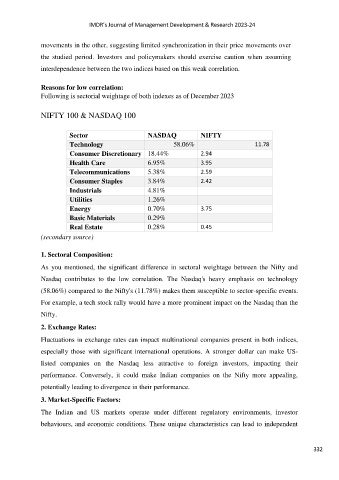Page 340 - IMDR JOURNAL 2023-24
P. 340
IMDR’s Journal of Management Development & Research 2023-24
movements in the other, suggesting limited synchronization in their price movements over
the studied period. Investors and policymakers should exercise caution when assuming
interdependence between the two indices based on this weak correlation.
Reasons for low correlation:
Following is sectorial weightage of both indexes as of December 2023
NIFTY 100 & NASDAQ 100
Sector NASDAQ NIFTY
Technology 58.06% 11.78
Consumer Discretionary 18.44% 2.94
Health Care 6.95% 3.95
Telecommunications 5.38% 2.59
Consumer Staples 3.84% 2.42
Industrials 4.81%
Utilities 1.26%
Energy 0.70% 3.75
Basic Materials 0.29%
Real Estate 0.28% 0.45
(secondary source)
1. Sectoral Composition:
As you mentioned, the significant difference in sectoral weightage between the Nifty and
Nasdaq contributes to the low correlation. The Nasdaq's heavy emphasis on technology
(58.06%) compared to the Nifty's (11.78%) makes them susceptible to sector-specific events.
For example, a tech stock rally would have a more prominent impact on the Nasdaq than the
Nifty.
2. Exchange Rates:
Fluctuations in exchange rates can impact multinational companies present in both indices,
especially those with significant international operations. A stronger dollar can make US-
listed companies on the Nasdaq less attractive to foreign investors, impacting their
performance. Conversely, it could make Indian companies on the Nifty more appealing,
potentially leading to divergence in their performance.
3. Market-Specific Factors:
The Indian and US markets operate under different regulatory environments, investor
behaviours, and economic conditions. These unique characteristics can lead to independent
332

